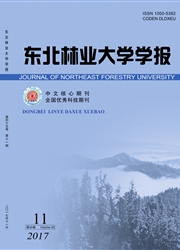

 中文摘要:
中文摘要:
群落复杂性是生态复杂性在群落水平上的具体表现,体现了群落结构与功能的综合特征,是生态系统的重要组成要素。应用Shannon-Wiener生态位宽度、Pianka生态位重叠和Anand群落复杂性等公式,定量研究了黄土高原马栏林区辽东栎(Quercus liaotungensis)群落、油松(Pinus tabulaeformis)群落和白桦(Betula platyphylls)群落主要树种的生态位宽度、生态位重叠以及群落复杂性特征,同时对群落复杂性与土壤养分状况的关系进行了分析。结果表明:①群落总体复杂性是天然油松林〉辽东栎林〉白桦林,演替顶极群落并不一定最复杂;②群落乔木树种的平均生态位宽度为辽东栎林〉白桦林〉油松林,群落乔木树种生态位平均重叠值为白桦林〉辽东栎林〉油松林,辽东栎群落生态位分化程度较高;③群落复杂性与土壤环境中的速效钾含量和pH值没有明显关系,但与速效磷含量有极显著的负相关关系,这说明速效磷对研究地区群落复杂性有很大影响,是制约群落复杂性的主要因子。通过群落土壤养分状况与乔木树种生态位特征能很好地分析理解群落复杂性现状。
 英文摘要:
英文摘要:
Niche breadth, niche overlapping of the main species in Quercus liaotungensis communities, Pinus tabulaeformis communities and Betula platyphylla communities in Malan Forest Region on the Loess Plateau and the characteristics of community complexity were quantitatively studied using Shannon-wiener niche breadth formula, Pianka's niche overlap formula and Anand community complexity formula, and the relationship between community complexity and soil factors were analyzed. Results showed that the community complexity of P. tabulaeformis community was the highest and that of B. platyphylla community was the lowest, the climax community was not always the most complex. The average niche breadth of arbor species in Q. liaotungensis community, was the highest and that in P. tabulaeformis community was the lowest, while the average niche overlap of arbor species in B. platyphylla community was the highest and that in P. tabulaeformis community was the lowest, and the ecological niche differentiation in Q. liaotungensis community was higher. There were no obvious correlations between community complexity and the content of available kalium and pH in the soil, but there was a significant negative correlation between community complexity and the content of available phosphate, which indicates that the available phosphorus has a big effect on community complexity of the region, and is the main factor restricting community complexity. Soil nutrient status of the community and the characteristics of tree species niche could be used to accurately analyze the status quo of community complexity.
 同期刊论文项目
同期刊论文项目
 同项目期刊论文
同项目期刊论文
 期刊信息
期刊信息
